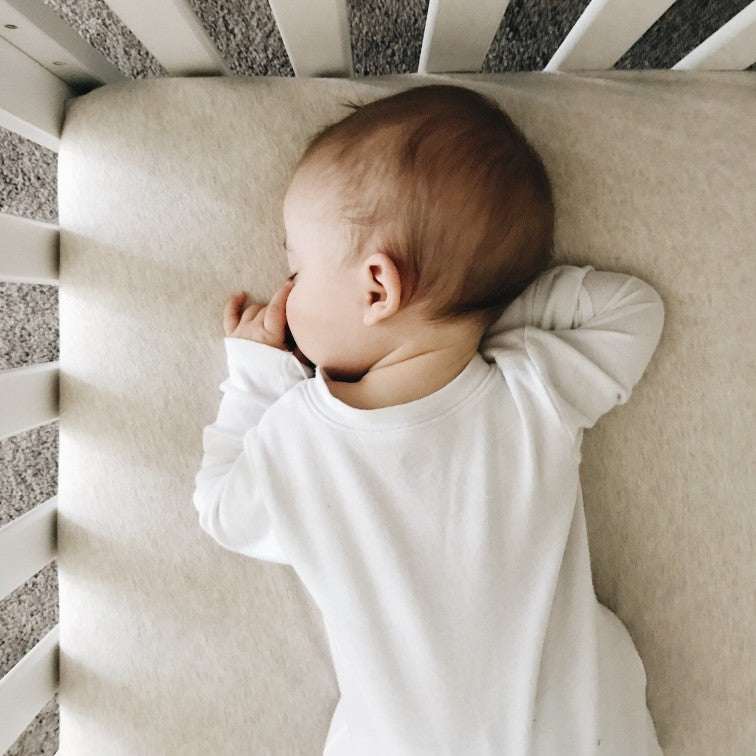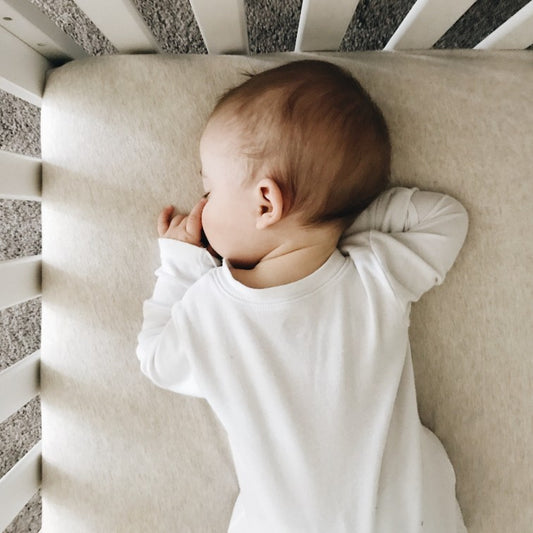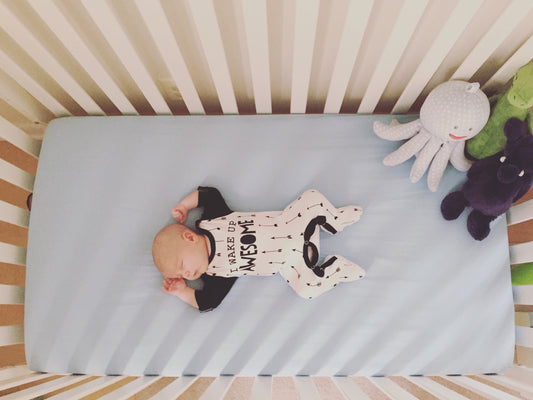Written by: Rachel Norman

With my first two babies I had a goal: I wanted those kids to sleep through the night!
I remember the first few times my daughter slept through the night. I remember them because I would still wake up every hour or two and go check on her to make sure she was breathing.
This is what happens.
Your baby finally sleeps through the night now you’re the one waking up all the time just to make sure they’re okay.
One goal every mother has for their little one: to sleep through the night soundly.
Babies who sleep well at night are more content, happy, and sociable during the day!
What does it look like for baby to go to sleep on his or her own?
The end goal when putting down our babies and toddler is to put them in their cribs while they are awake, semi-awake or drowsy. While it is so nice to rock them to sleep, kiss them and put them into bed, that often results in them waking up as their head hits the pillow or 45 minutes later when they transition through a sleep phase and aren’t able to get back to sleep on their own.
By putting them down drowsy or, for small babies, semi-awake, then they are actually doing the “hard work” of getting to sleep themselves.

Set the scene
Usually, we’re right in front of the crib with the lights low and white noise (or music) on. The nap or bedtime routine has been complete and they know it’s bedtime. That actually makes it so much easier because baby knows what’s coming and it’s become routine. This is called a sleep association.
Gentle Rocking (in a chair or in your arms)
I like to rock my babies and pre-toddlers gently to get them in a drowsy mood. I will not rock until they are fully asleep, but rock until they are lulled or doing a slight eye roll. You know the one. Then take them and put them into the crib. If you have to be so gentle you worry waking them, it’s probably too much rocking. Rocking in itself is not bad, it just creates a problem (a sleep prop) when your baby can’t get to sleep without it.
Sitting with baby upright
One method of getting baby drowsy and ready for bed is holding him upright against your chest while sitting. The trick here is that you are very still and not moving. They will also begin to associate this with part of the pre-sleep routine. When they begin to lay his head on your shoulder then you’ll know it’s time to put him in the crib. You may do this for as long as 5 minutes, and it's a calming time for baby.
Patting the belly or rubbing the back
Another way to achieve the drowsy effect is to put baby into his crib and gently pat his stomach or to rub his back. I have personally kissed and cuddled and put them into their beds and patted their stomachs. I would be careful not to make too much eye contact here or he or she will start smiling and giggling, which is precious but not conducive to easy napping.
Cradling
I love holding my little ones (even my 18-month-old now) in the cradle position as though he is tiny. They love looking at you or playing with your hair or hearing you sing. This is probably my favorite way.
Singing
I am a sappy mother and make up a song for each of my kids to the same tune. I’ve written them in their baby book so I don’t forget them. Singing a song at a low volume is a great way to help prepare and lull them to sleep. My son asks for the same song every nap and bedtime and it is a great sleep association.
Recognizing the sleep window
A very important concept to remember is that of the sleep window. This is the point at which it will be easiest to get them to nap or go to bed on their own because they are tired and showing signs of tiredness but not yet over-tiredness.
Crying, as a symptom of tiredness, is already past that point of fussiness. So if your children wake at 6:30 a.m. and by 1:30 p.m they are fussy and crying, that’s a good sign that nap time should occur somewhere earlier. Perhaps at 12:30 or 1:00 p.m.
Babies and then toddlers will often tug their ears, yawn, eye roll, rub their eyes, and start acting slightly “out of it” and then you can know that’s a good time to take them immediately to bed. If you pass the sleep window then they will likely become “overtired” which means they will have a difficult time getting to sleep and, once asleep, staying asleep.
Do yourself and your baby a favor and pick up the SoundBub white noise machine. This will help keep your baby’s sleep consistent and bring peace and comfort to baby.
For mothers who want their babies to begin sleeping through the night I highly recommend using white noise all night. White noise becomes a positive sleep association as they wind-down for sleep then, when they transition through sleep cycles in the evening they will still hear that noise and it’ll help them keep sleeping instead of waking up.
One super cute and highly functional white noise machine is the SoundBub. It not only has white noise and is a Bluetooth speaker, it syncs with WavHello’s VoiceShare app.
The reason this app is awesome is because you can actually record songs, stories, poems, and even prayers you can then play for your baby at various times. During your wind-down routine you can play whatever you prefer for baby then, as they are ready to drift to sleep, turn on the white noise throughout their nap or night sleep.
The SoundBub white noise machine is perfect for the nursery or when you’re on the go because it’s hide away hook can clip easily onto strollers, car seats, and even baby carriers.
This post is part of an 8-post series:
Part 1: What To Focus On During The First Week With A Newborn
Part 2: The Importance Of Swaddling: How And Why
Part 3: How To Create A Wind-Down Routine For Baby
Part 4: The Sleep Window: How To Recognize Baby’s Sleep Cues
Part 5: Classic Signs Of Overtiredness And How To Prevent It
Part 6: A Surefire Way To Help Baby Sleep More Soundly
Part 7: Early Morning and Dream Feeds: How To Do Them And Wean Them
Part 8: The Art Of Teaching Baby To Sleep On Their Own (you are here)







